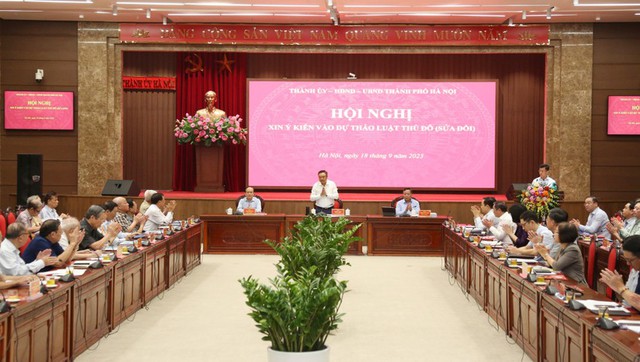Capital targets to transform into smart, modern urban area
VGP - The implementation of the amended Capital Law would pave the way for Ha Noi to reach new heights in its development process and transform the city into a smart, modern, green, clean, beautiful, safe, and secure urban area, characterized by rapid, sustainable, and comprehensive development, said Tran Sy Thanh, Chairman of the Ha Noi People’s Committee.

Tran Sy Thanh, Chairman of the Ha Noi People’s Committee at the meeting to discuss revising the amended Capital Law
The Chairman made the remarks during a meeting on September 18 to discuss revising the amended Capital Law.
Thanh underscored the significant importance of the conference, stating that it serves as a pivotal foundation for the city's continued efforts in finalizing the amended Capital Law Project, which will be submitted to the 6th session of the 15th National Assembly in October 2023.
The city's mayor pointed out that the law's primary aim is to address the challenges, obstacles, and shortcomings that have arisen during the implementation of the Capital Law since 2012.
It seeks to enhance the legal framework, establish a distinctive and pioneering mechanism, and create favorable conditions for the growth and development of Ha Noi as a capital city in line with its role and responsibilities as a political-administrative hub, as well as a significant center for business, culture, education, training, science, technology, and international integration.
With these objectives in mind, the amended Capital Law Project aims to introduce exceptional mechanisms and policies tailored to meet the increasing challenges anticipated in the next phase of development for the capital. It will also delegate matters requiring legislative authority will be delegated to the relevant agencies by current laws, ensuring both feasibility and uniformity.
The law will outline Ha Noi's responsibilities and mechanisms for monitoring and controlling the exercise of powers and duties at all levels of the city's authorities.
However, Thanh suggested that the amended Capital Law would build on the proven provisions of the 2012 Capital Law and integrate specific mechanisms and policies that have already been tested in provinces and tier 1 cities to suit the capital's context.
The scope of adjustments in the draft Law is primarily rooted in Article 1 of the 2012 Capital Law. This new draft Law elaborates on and supplements various aspects of government organization in the capital, budgetary matters, and resource mobilization for investment and development in the Capital and its interconnected regions, all within the limits defined by the Law.
Specifically, the Capital Law stipulates positions and roles, structures of government bodies, financial arrangements, budgeting procedures, resource mobilization strategies, and the overarching responsibilities for the planning, management, and protection of the capital itself, along with fostering development in the surrounding capital region.
The framework of the draft Law encompasses seven chapters and 59 articles, signifying an expansion of three chapters and 32 articles compared to the 2012 Capital Law. These provisions strongly emphasize decentralization, a reinvigorated governance model, and an increase in the capital's self-governance and accountability across all facets of its socioeconomic landscape. The principle of prioritizing the application of the Capital Law has been incorporated to ensure the Law's continued effectiveness, even in cases where subsequent laws and National Assembly resolutions introduce differing provisions.
"The amended Capital Law is a unique and pioneering piece of legislation. It introduces a variety of distinctive and innovative mechanisms, exerting a far-reaching impact that sets it apart from many existing laws and subordinate legal documents," Thanh said./.

